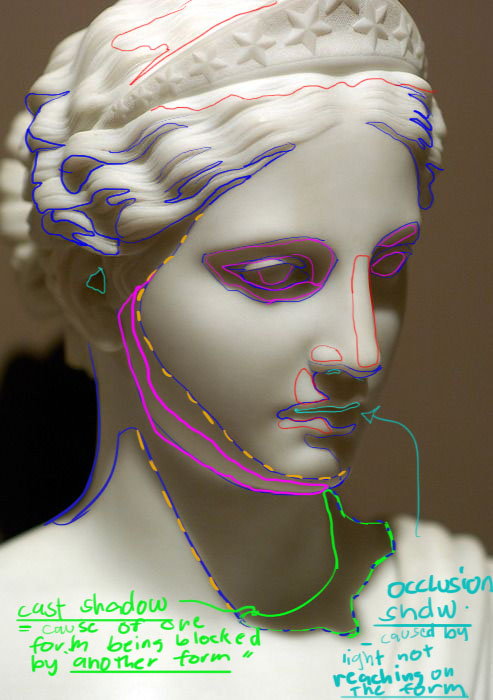07-28-2016, 05:14 AM
Hey guys, I'm realizing that I never really went into much depth when studying light/form and now my lack of understanding is coming back to bite me. Anyways I'm really struggling to apply the form principle when it comes to more complex objects such as faces, and in general finding where the separation of lights and darks occur.
I'm attaching two images here, one for reference and the other marked with areas where I'm confused as to whats going on. I don't have the greatest handwriting, and so I'll also just write out my questions for clarity.
Are the lines I marked out down the nose, below his eyes, and cheeks where the terminator is? Would the corresponding section afterwards would be the form shadow? Would the completely black areas be cast shadows or occlusion shadows? Is his forehead in light or shadow since it seems to be a gradation? How would I describe the left side of his face since it's in shadow but a small amount of light is still hitting it? Would the left side be considered in light or shadow?
I apologize if I've complicated this but it's been frustrating me for the past few days; to the point I'm literally asking myself, man the hell is going on here? In any case, anything that would help me understand this better would be appreciated :)
I'm attaching two images here, one for reference and the other marked with areas where I'm confused as to whats going on. I don't have the greatest handwriting, and so I'll also just write out my questions for clarity.
Are the lines I marked out down the nose, below his eyes, and cheeks where the terminator is? Would the corresponding section afterwards would be the form shadow? Would the completely black areas be cast shadows or occlusion shadows? Is his forehead in light or shadow since it seems to be a gradation? How would I describe the left side of his face since it's in shadow but a small amount of light is still hitting it? Would the left side be considered in light or shadow?
I apologize if I've complicated this but it's been frustrating me for the past few days; to the point I'm literally asking myself, man the hell is going on here? In any case, anything that would help me understand this better would be appreciated :)










![[Image: 6b7c5ef81db58882b0c202b3aa584d1f.jpg]](https://s-media-cache-ak0.pinimg.com/564x/6b/7c/5e/6b7c5ef81db58882b0c202b3aa584d1f.jpg)
![[Image: nM08MFy.jpg]](http://i.imgur.com/nM08MFy.jpg)

